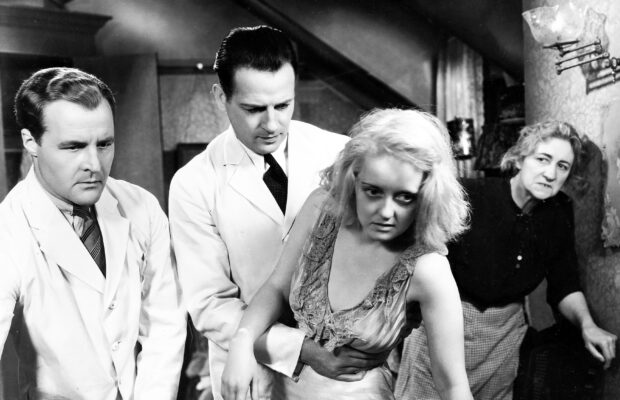Of Human Bondage (1934)

Toronto Film Society presented Of Human Bondage (1934) on Saturday, May 18, 2024 as part of the Season 76 Virtual Film Buffs Screening Series, Programme 9.
Production Company: RKO Radio Pictures. Producer: Pandro S. Berman. Director: John Cromwell. Screenplay: Lester Cohen, based on the novel Of Human Bondage by W. Somerset Maugham, dialogue by Ann Coleman. Cinematographer: Henry W. Gerrard. Editor: William Morgan. Music: Max Steiner. Costumes: Walter Plunkett. Released June 28, 1934.
Cast: Bette Davis (Mildred), Leslie Howard (Philip), Frances Dee (Sally), Kay Johnson (Norah), Reginald Denny (Griffiths), Alan Hale (Miller), Reginald Owen (Athelny).

In 1934, an actress mesmerized audiences with a powerhouse performance that would capture the attention of everyone who came to watch her: Bette Davis. She became the talk of the town, and her work was so strong she was responsible for a momentary change in Oscar rules, allowing Academy members to write-in votes when she wasn’t officially nominated. Many believe that her loss that year was the reason she ended up winning the year after for a much lesser performance.
Of Human Bondage is based on the 1915 novel of the same name by W. Somerset Maugham. The story follows a young man named Philip Carey, played by Leslie Howard, who becomes infatuated with a manipulative and self-destructive waitress named Mildred Rogers, portrayed with intense ferocity by Bette Davis.
Throughout the film, their relationship undergoes profound shifts, characterized by moments of tension, manipulation, and dependency. Against the backdrop of societal norms and power imbalances, Philip and Mildred’s interactions serve as a poignant exploration of human frailty and desire, ultimately revealing the complexities of love and obsession.
In translating W. Somerset Maugham’s seminal novel to the screen, the 1934 version of Of Human Bondage made several notable departures from its source material. While Maugham’s narrative delves deeply into the psychological complexities of its characters, the film adaptation streamlined certain aspects of the story, emphasizing dramatic tension and emotional resonance. These alterations served to heighten the film’s impact and ensure its accessibility to a wider audience, while still capturing the essence of Maugham’s themes.
The film came out during the tumultuous era of the Great Depression, a time marked by economic despair and social upheaval. Against this backdrop, the film’s exploration of personal struggle and disillusionment resonated deeply with audiences grappling with their own hardships. Additionally, the release occurred amidst the enforcement of the Motion Picture Production Code, commonly known as the Hays Code. This set of industry guidelines, named after its chief architect, Will H. Hays, was implemented in response to growing concerns about the moral content of films. The Hays Code aimed to regulate the portrayal of sensitive topics such as sex, violence, and morality to maintain a standard of decency and propriety in American cinema.

Specifically, the Hays Code prohibited the depiction of certain taboo subjects, including adultery, promiscuity, and explicit sexuality. As a result, the filmmakers behind the 1934 adaptation of Of Human Bondage were tasked with navigating these restrictions while remaining faithful to the novel’s themes and narrative.
To adhere to the guidelines of the Hays Code, certain aspects of W. Somerset Maugham’s novel may have been toned down or altered in the film adaptation. Scenes or dialogue deemed too explicit or morally questionable may have been modified or omitted altogether, resulting in a sanitized portrayal of the story’s more controversial elements.
Despite these challenges, the filmmakers managed to craft a compelling and emotionally resonant adaptation that retained much of the novel’s thematic richness and psychological depth. Ultimately, the adaptation stands as a testament to the creative ingenuity of filmmakers working within the constraints of censorship, offering a poignant exploration of human desire and vulnerability within the parameters of the Hays Code era.
Leslie Howard’s portrayal of Philip remains a benchmark of nuanced and emotive acting. Howard deftly conveys Philip’s internal struggles and vulnerabilities, endowing the character with a palpable sense of humanity and depth. Similarly, Bette Davis delivers a tour-de-force performance as Mildred, infusing the character with a potent blend of allure, cruelty, and desperation. Their on-screen chemistry adds layers of complexity to their characters’ tumultuous relationship, captivating audiences with its raw intensity.
Director John Cromwell’s masterful use of visual and cinematic techniques imbues the film with a haunting and atmospheric quality. Through evocative lighting, composition, and art direction, Cromwell transports viewers to the gritty streets of Depression-era London, immersing them in the stark realities of the characters’ lives. These visual elements not only enhance the film’s emotional resonance but also serve as potent storytelling devices, enriching the narrative with layers of meaning and symbolism.
Upon its release, the film garnered a mix of critical acclaim and controversy. While many praised the film’s powerful performances and emotional depth, others criticized its deviations from the source material or its handling of sensitive subject matter. Nevertheless, the film’s enduring legacy as a classic of Golden Age Hollywood cinema underscores its lasting impact and significance within the cinematic landscape. It has secured its place as a timeless classic, and its enduring influence is evident in the numerous adaptations and reinterpretations that have followed, attesting to the relevance of its narrative and characters.
The film cemented Leslie Howards’ name in the industry and catapulted Bette Davis to superstardom, which she followed with many iconic performances, in a career that spanned decades, giving us classic titles such as All About Eve, Now, Voyager, The Letter, and What Ever Happened to Baby Jane? It’s a classic in the true sense of the word, and a must-watch for any movie lover.
Notes by Leandro Matos










Leave a Reply